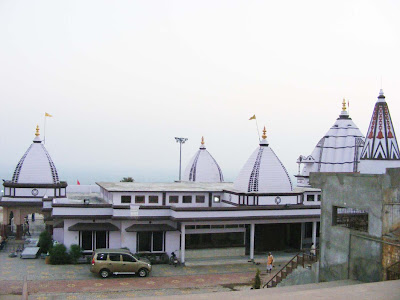City: Indore
State: N/A
Country: India
Introduction to Bada Ganapati Indore :
Bada Ganapati Temple is located at Indore, the former Holkar Dynasty ruled over the city for a long time. It had been the most prestigious and worthwhile visiting places of India, since the temple of Sri Ganesh is located there. Ganesh is considered as a God who is benevolent and most exquisite looking with the tusk of an elephant. In South India he is one of the most worshipped Gods.
Specially, Lord Ganesh is being revered in each and every house so that the blessings of the Lord help the members to find the path to success and they may also progress in this world without obstacles.Lord Ganesh is a kind hearted God but according to mythology he loves to eat. So, during the Ganesh Chaturthi, the lord is given numerous sweets and other preparations so that mankind may be blessed by him wholeheartedly.
Ganesh Chaturthi is a special kind of Indian Festival when Lord Ganapati Bappa is worshipped with elegance and tremendous wealth is displayed because the poor and the destitute are given clothes and food at that time.
Better known for its size than antiquity, this temple houses perhaps the largest Ganesh idol in the world, measuring 25 ft. from crown to foot. Created as a result of a dream to an Avantika (Ujjain) resident Shri Dadhich, it was built in 1875. The idol has a most interesting configuration of ingredients: bricks, lime stone, masala made of Gud, methi dana, soil collected from seven moksha puris: Ayodhya, Mathura, Maya, Kashi, Kanchi, Avantika, and Dwaraka, mud from stables of horse, elephant and cow, the powder of Pancharatna : heera, panna, moti, manek and pukhraj (diamond, emerald, pearl, ruby and topaz) and the holy water from all major places of pilgrimage. The metalic frame is of gold, silver, copper, brass and iron
Built in the year 1875, during the reign of Rani Ahilya Bai Holkar, Khajrana is famous for housing the largest Ganapati statue in the world. From crown to foot the deity measures eight meters in length
Made up of a weird mix of limestone, jaggery, bricks, mud from the stables of elephants and horses, besides holy soil and water from the major pilgrim places and the deity’s image generate a significant impact on the devotee. Deity’s frame is made of precious metals, and the deity looks amazingly wonderful.
The popular belief is that Bada Ganapati is the hinderer of all obstacles so devotees render highest regard to this idol.The gigantic statue of Ganapati is a fascinating attraction of this pilgrim center and large folks frequents here to have a darshan of this gorgeous deity.
Bada in Hindi means large, so the temple is known as Bada Ganapati Temple, since it encloses the large statue of Lord Ganapati Bappa. Created as a result of the dream of an Avantika (Ujjain) resident, Shri Dadhich, it was built in 1875 . Bada Ganapati is a worthwhile site at Indore. It consists of a huge statue of Lord Ganesh, perhaps the largest in the world, which is approximately 25 feet tall and the color of the statue is Bright Orange. The idol is made up of bricks, lime stone, masala made of Gud, methi dana, soil collected from seven moksha puris, namely Ayodhya, Mathura, Maya, Kashi, Kanchi, Avantika, and Dwaraka, mud from stables of horse, elephant and cow, the powder of Pancharatna: heera, panna, moti, manek and pukhraj (diamond, emerald, pearl, ruby and topaz respectively) and the holy water from all major places of pilgrimage. The metallic frame is of gold, silver, copper, brass and iron. It serves as a place for both wonder and worship.
This temple houses perhaps the largest Ganesh idol in the world measuring 25 feet from crown to foot. Created as a result of the dream of an Avantika (Ujjain) resident, Shri Dadhich, it was built in 1875. The idol has a most interesting configuration of ingredients; bricks, limestone, masala made of gud (jaggery), methi dana, soil collected from the seven mokshapuri:
Unlike many other Ganesha temples in Indore or in India, the Bada Ganapati temple has the largest of all Ganesha Idols in the world, soaring 25 feet or 8m high! It was built in 1875 by a resident of Ujjain, who dreamt about Lord Ganesha. This persuaded her to launch a huge idol of the generous god, Ganesha. The idol is built using an alloy of several metals like silver, gold, brass, iron and copper, which gives it an orange color. Unlike other Ganesha statues, this idol is unique in that, it also has a mixture of several natural ingredients like turmeric, jaggery, powder of five gem-stones (pancha-ratna), mud from stables of cow and elephant holy water from pilgrimage places and soil from moksha-puris. The Big Ganapati (Bada Ganapati) Temple is a shrine for ultimate reverence of the benevolent god.
History of Bada Ganapati:
It was built in the year 1875. According to the mythology, one of the residents of the city of Avantika or Ujjain dreamt of Lord Ganesh in his sleep. So, he rose up on the next day and prepared for the enormous statue of Lord Ganesha, so that the Lord blesses him. Bada in Hindi means large, so the temple is known as Bada Ganapati Temple, since it encloses the large statue of Lord Ganapati Bappa.
Description of Bada Ganapati:
The Bada Ganapati is a worthwhile site at Indore. It consists of a huge statue of Lord Ganesh, perhaps the largest in the world, which is approximately 25 feet tall and the color of the statue is Bright Orange.
You can reach Indore by train or plane. After that get hold of the bus or car that ply in the city and they would enable you to reach the Bada Ganapati, Indore.
Nearby cities:
samarth residency gram nenod, Silicon City, phoenix city
samarth residency gram nenod, Silicon City, phoenix city
Coordinates:
22°43'14"N 75°50'31"E
22°43'14"N 75°50'31"E










.jpg)


























